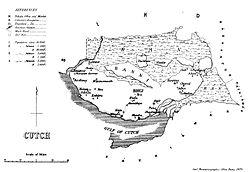Kingdom of Kutch (1147–1819) Cutch State (1819–1947) કચ્છ | |||||||||||
|---|---|---|---|---|---|---|---|---|---|---|---|
| 1147–1947 | |||||||||||
 Cutch State, 1878 | |||||||||||
| Capital | Lakhiarviro (1147―1548) Bhuj (1549―1947) | ||||||||||
| Common languages | Kutchi, Gujarati, Sindhi | ||||||||||
| Religion | Hinduism (official) | ||||||||||
| Government | Monarchy | ||||||||||
| History | |||||||||||
• Established | 1147 | ||||||||||
• came under Cutch Agency of Company | 1819 | ||||||||||
| 1947 | |||||||||||
| Area | |||||||||||
| 1901[1] | 19,725 km2 (7,616 sq mi) | ||||||||||
| Population | |||||||||||
• 1901[1] | 488,022 | ||||||||||
| Currency | Kutch kori | ||||||||||
| |||||||||||
| Today part of | India | ||||||||||
Cutch State, also spelled Kutch or Kachchh and also historically known as the Kingdom of Kutch, was a kingdom in the Kutch region from 1147 to 1819 and a princely state under British rule from 1819 to 1947. Its territories covered the present day Kutch region of Gujarat north of the Gulf of Kutch. Bordered by Sindh in the north, Cutch State was one of the few princely states with a coastline.
The state had an area of 7,616 square miles (19,725 km2) and a population estimated at 488,022 in 1901.[1] During the British Raj, the state was part of the Cutch Agency and later the Western India States Agency within the Bombay Presidency. The rulers maintained an army of 354 cavalry, 1,412 infantry and 164 guns.[citation needed]

